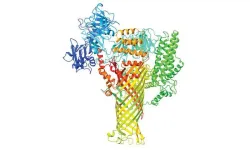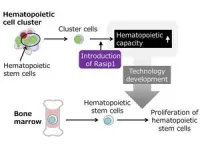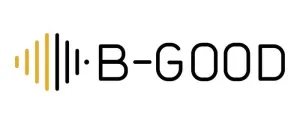(Press-News.org) DURHAM, N.C. -- Many of the bacteria that ravage crops and threaten our food supply use a common strategy to cause disease: they inject a cocktail of harmful proteins directly into the plant’s cells.
For 25 years, biologist Sheng-Yang He and his senior research associate Kinya Nomura have been puzzling over this set of molecules that plant pathogens use to cause diseases in hundreds of crops worldwide ranging from rice to apple trees.
Now, thanks to a team effort between three collaborating research groups, they may finally have an answer to how these molecules make plants sick -- and a way to disarm them.
The findings appear Sept. 13 in the journal Nature.
Researchers in the He lab study key ingredients in this deadly cocktail, a family of injected proteins called AvrE/DspE, that cause diseases ranging from brown spot in beans and bacterial speck in tomatoes to fire blight in fruit trees.
Ever since their discovery in the early 1990s, this family of proteins has been of great interest to those who study plant disease. They are key weapons in the bacterial arsenal; knocking them out in a lab renders otherwise-dangerous bacteria harmless. But, despite decades of effort, many questions about how they work remain unanswered.
Researchers had identified a number of proteins in the AvrE/DspE family that suppressed the plant’s immune system, or that caused dark water-soaked spots on a plant’s leaves -- the first telltale signs of infection. They even knew the underlying sequence of amino acids that linked to form the proteins, like beads on a string. But they didn’t know how this string of amino acids folded into a 3D shape, so they couldn’t easily explain how they worked.
Part of the problem is that the proteins in this family are huge. Whereas an average bacterial protein might be 300 amino acids long; AvrE/DspE-family proteins are 2000.
Researchers have looked for other proteins with similar sequences for clues, but none with any known functions showed up.
“They’re weird proteins,” He said.
So they turned to a computer program released in 2021 called AlphaFold2, which uses artificial intelligence to predict what 3D shape a given string of amino acids will take.
The researchers knew that some members of this family help the bacteria evade the plant’s immune system. But their first glimpse of the proteins’ 3D structure suggested an additional role.
“When we first saw the model, it was nothing like what we had thought,” said study co-author Pei Zhou, a professor of biochemistry at Duke whose lab contributed to the findings.
The researchers looked at AI predictions for bacterial proteins that infect crops including pears, apples, tomatoes and corn, and they all pointed to a similar 3D structure. They appeared to fold into a tiny mushroom with a cylindrical stem, like a straw.
The predicted shape matched up well with images of a bacterial protein that causes fire blight disease in fruit trees that was captured using a cryo-electron microscope. From the top down, this protein looked very much like a hollow tube.
Which got the researchers thinking: Perhaps bacteria use these proteins to punch a hole in the plant cell membrane, to "force the host for a drink" during infection, He said.
Once bacteria enter the leaves, one of the first areas they come across is a space between cells called the apoplast. Normally, plants keep this area dry to enable gas exchange for photosynthesis. But when bacteria invade, the inside of the leaf becomes waterlogged, creating a moist cozy haven for them to feed and multiply.
Further examination of the predicted 3D model for the fire blight protein revealed that, while the outside of the straw-like structure is water-resistant, its hollow inner core has a special affinity for water.
To test the water channel hypothesis, the team joined forces with Duke biology professor Ke Dong and co-first-author Felipe Andreazza, a postdoctoral associate in her lab. They added the gene readouts for the bacterial proteins AvrE and DspE to frog eggs, using the eggs as cellular factories for making the proteins. The eggs, placed in a dilute saline solution, quickly swelled and burst with too much water.
The researchers also tried to see if they could disarm these bacterial proteins by blocking their channels. Nomura focused on a class of tiny spherical nanoparticles called PAMAM dendrimers. Used for more than two decades in drug delivery, these dendrimers can be made with precise diameters in a lab.
“We were tinkering with the hypothesis that if we found the right diameter chemical, maybe we could block the pore,” He said.
After testing different sized particles, they identified one they thought might be just the right size for jamming the water channel protein produced by the fire blight pathogen, Erwinia amylovora.
They took frog eggs engineered to synthesize this protein and doused them with the PAMAM nanoparticles, and water stopped flowing into the eggs. They didn’t swell.
They also treated Arabidopsis plants infected with the pathogen Pseudomonas syringae, which causes bacterial speck. The channel-blocking nanoparticles prevented the bacteria from taking hold, reducing pathogen concentrations in the plants’ leaves by 100-fold.
The compounds were effective against other bacterial infections too. The researchers did the same thing with pear fruits exposed to the bacteria that cause fire blight disease, and the fruits never developed symptoms -- the bacteria didn’t make them sick.
“It was a long shot, but it worked,” He said. “We're excited about this.”
The findings could offer a new line of attack against many plant diseases, the researchers said.
Plants produce 80% of the food we eat. And yet more than 10% of global food production --crops such as wheat, rice, maize, potato and soybean -- are lost to plant pathogens and pests each year, costing the global economy a whopping $220 billion.
The team has filed a provisional patent on the approach.
The next step, said Zhou and co-first-author Jie Cheng, a Ph.D. student in Zhou’s lab, is to figure out how this protection works, by getting a more detailed look at how the channel-blocking nanoparticles and the channel proteins interact.
“If we can image those structures we can have a better understanding and come up with better designs for crop protection,” Zhou said.
This work was supported by the National Institute of Allergy and Infectious Diseases (1R01AI155441) and the National Institute of General Medical Sciences (GM145026), both at the National Institutes of Health, Duke Science and Technology, and the Howard Hughes Medical Institute.
CITATION: "Bacterial Pathogens Deliver Water/Solute-Permeable Channels as a Virulence Strategy," Kinya Nomura, Felipe Andreazza, Jie Cheng, Ke Dong, Pei Zhou, and Sheng Yang He. Nature, Sept. 13, 2023. DOI: 10.1038/s41586-023-06531-5
END
Mysterious family of microbial proteins hijack crops’ cellular plumbing
Duke researchers may have come up with a way to disarm them, preventing $220 billion in annual crop damage
2023-09-13
ELSE PRESS RELEASES FROM THIS DATE:
World-first AI foundation model for eye care to supercharge global efforts to prevent blindness
2023-09-13
Researchers at Moorfields Eye Hospital and UCL Institute of Ophthalmology have developed an artificial intelligence (AI) system that has the potential to not only identify sight-threatening eye diseases but also predict general health, including heart attacks, stroke, and Parkinson’s disease.
RETFound, one of the first AI foundation models in healthcare, and the first in ophthalmology, was developed using millions of eye scans from the NHS. The research team are making the system open-source: freely available to use by any institution worldwide, to act as a cornerstone for global efforts to detect and treat blindness using AI. ...
Researchers identify lesser-known factors associated with firearm violence
2023-09-13
Key takeaways
Social determinants of at-risk neighborhoods: Higher proportions of poverty and low per-capita income were most associated with higher rates of shooting incidents.
High levels of social stressors: The study found that fatal and non-fatal firearm assaults were clustered in neighborhoods with high levels of social stressors measured with the 2018 version of the Centers for Disease Control and Prevention’s (CDC) Social Vulnerability Index (SVI).
A potential tool for directing anti-violence initiatives: The CDC’s SVI can help policymakers target neighborhoods at ...
The origins of blood: Researchers identify a gene critical to blood production
2023-09-13
Researchers from Tokyo Medical and Dental University (TMDU) have discovered that a gene called Rasip1 is intimately involved in the creation of blood cells
Tokyo, Japan – Blood has long been a symbol of life and health, so it may be surprising that some aspects of blood production, i.e., hematopoiesis, remain incompletely understood. One such mystery is the role of a protein called SOX17. Blood cells are generated by hematopoietic stem cells (HSCs), and SOX17 seems to be important to the development of HSCs because SOX17 is expressed where HSCs first develop. What exactly SOX17 does, however, has remained unclear.
Now, a research team at Tokyo Medical and Dental University (TMDU) ...
Ohio’s droughts are worse than often recognized, study finds
2023-09-13
COLUMBUS, Ohio – A new type of analysis suggests that droughts in Ohio were more severe from 2000 to 2019 than standard measurements have suggested.
Researchers at The Ohio State University developed impacts-based thresholds for drought in Ohio, looking specifically at how corn yield and streamflow were affected by various drought indicators, such as notable changes in soil moisture, crops, and even livestock losses in the state.
The results suggest this impacts-based approach could give Ohio farmers earlier and more accurate notice when drought conditions are approaching, said Steven Quiring, co-author of the study and a professor ...
Building the first-ever digital twin of the bladder
2023-09-13
Men ages 50 to 60 have an 80 percent chance of having some degree of bladder outlet obstruction (BOO) due to an enlarged prostate – which causes multiple symptoms that can impact their lives physically and psychologically.
The bladder, an incredibly complex organ, has its own electrical system and can change its constituents and geometry through a growth and remodeling process. However, in bladders with BOO, the urethral resistance increases and forces the muscle cells within the bladder to generate larger pressures to void. Over time, the bladder adapts with a growth and remodeling response that causes changes in bladder size, tissue composition, ...
B-GOOD invites participants to its closing conference in Slovenia this October
2023-09-13
The EU Horizon 2020 project B-GOOD, aiming at improving honey bee health and beekeeping sustainability, invites participants to the project’s closing conference in Bled, Slovenia this October. The upcoming scientific event will feature oral presentations, poster sessions, and information market stands to provide a comprehensive overview of the results and technologies developed during the project. The attendees will also be able to meet the consortium members of the project, ask questions and exchange ideas.
The event will take place on the 2nd of October 2023 immediately before the COLOSS ...
UTSA study: More Texas owls are testing positive for rat poisons
2023-09-13
New research suggests that owls in Texas have high rates of anticoagulant rodenticides (AR)—blood thinning rat poisons—in their systems. Jennifer Smith, a professor of integrative biology in the UTSA College of Sciences, co-authored a research article published recently in PLOS ONE, the world’s first multidisciplinary open access journal.
Eres Gomez, M.S. ’22, a UTSA graduate who had conducted research in the Smith Wildlife Lab as a student, was the article’s lead author. Heather Prestridge, a curator ...
A novel method to obtain acetone more simply, safely and cheaply
2023-09-13
Acetone is an essential chemical industry input and is used in the manufacturing of a wide array of products, such as adhesives, antibiotics, electronic components, solvents and removers, inks and vitamins, among others. Its production is complex and hazardous. To simplify the process and make it safer and cheaper, researchers in Brazil and Germany have developed an innovative method that uses only light and photoactive iron chloride (FeCl3), an inexpensive chemical compound.
An article on the research, which was funded by FAPESP, is published in the ...
Life in boiling water
2023-09-13
Oak Ridge National Laboratory scientists studied hot springs on different continents and found similarities in how some microbes adapted despite their geographic diversity. The findings yield clues to the evolution of life and whether some of the hardiest microbes may be harnessed for biotechnology.
The study was the first of its kind to sample hot springs on three continents with water temperatures above 65 C (149 F) in the United States, Iceland and Japan. The environments have unique geology and chemistry, almost like a fingerprint, so it was surprising to find highly related microbes separated by thousands of miles, said ORNL’s Mircea Podar, co-lead of the ...
100-year floods could occur yearly by end of 21st century
2023-09-13
WASHINGTON — Most coastal communities will encounter 100-year floods annually by the end of the century, even under a moderate scenario where carbon dioxide emissions peak by 2040, a new study finds. And as early as 2050, regions worldwide could experience 100-year floods every nine to fifteen years on average.
A 100-year flood is an extreme water level that has a 1% chance of being exceeded in any given year and is based on historical data. Despite the name, 100-year floods can strike the same area multiple years in a row or not at all within a century. But a new study finds that those historical trends will no ...
LAST 30 PRESS RELEASES:
Injectable breast ‘implant’ offers alternative to traditional surgeries
Neuroscientists devise formulas to measure multilingualism
New prostate cancer trial seeks to reduce toxicity without sacrificing efficacy
Geometry shapes life
A CRISPR screen reveals many previously unrecognized genes required for brain development and a new neurodevelopmental disorder
Hot flush treatment has anti-breast cancer activity, study finds
Securing AI systems against growing cybersecurity threats
Longest observation of an active solar region
Why nail-biting, procrastination and other self-sabotaging behaviors are rooted in survival instincts
Regional variations in mechanical properties of porcine leptomeninges
Artificial empathy in therapy and healthcare: advancements in interpersonal interaction technologies
Why some brains switch gears more efficiently than others
UVA’s Jundong Li wins ICDM’S 2025 Tao Li Award for data mining, machine learning
UVA’s low-power, high-performance computer power player Mircea Stan earns National Academy of Inventors fellowship
Not playing by the rules: USU researcher explores filamentous algae dynamics in rivers
Do our body clocks influence our risk of dementia?
Anthropologists offer new evidence of bipedalism in long-debated fossil discovery
Safer receipt paper from wood
Dosage-sensitive genes suggest no whole-genome duplications in ancestral angiosperm
First ancient human herpesvirus genomes document their deep history with humans
Why Some Bacteria Survive Antibiotics and How to Stop Them - New study reveals that bacteria can survive antibiotic treatment through two fundamentally different “shutdown modes”
UCLA study links scar healing to dangerous placenta condition
CHANGE-seq-BE finds off-target changes in the genome from base editors
The Journal of Nuclear Medicine Ahead-of-Print Tip Sheet: January 2, 2026
Delayed or absent first dose of measles, mumps, and rubella vaccination
Trends in US preterm birth rates by household income and race and ethnicity
Study identifies potential biomarker linked to progression and brain inflammation in multiple sclerosis
Many mothers in Norway do not show up for postnatal check-ups
Researchers want to find out why quick clay is so unstable
Superradiant spins show teamwork at the quantum scale
[Press-News.org] Mysterious family of microbial proteins hijack crops’ cellular plumbingDuke researchers may have come up with a way to disarm them, preventing $220 billion in annual crop damage







